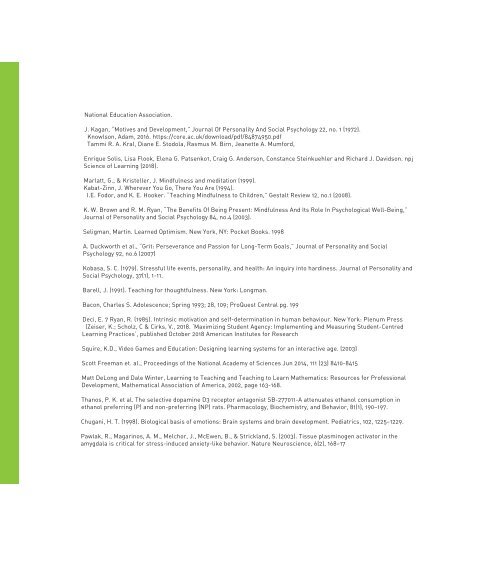Industry Guidelines on Digital Learning: Discussion Draft
The guidelines offered in this document are a first draft to provide a holistic system of characteristics and parameters important for delivering active and engaging learning through digital solutions.
The guidelines offered in this document are a first draft to provide a holistic system of characteristics and parameters important for delivering active and engaging learning through digital solutions.
Create successful ePaper yourself
Turn your PDF publications into a flip-book with our unique Google optimized e-Paper software.
Nati<strong>on</strong>al Educati<strong>on</strong> Associati<strong>on</strong>.<br />
J. Kagan, “Motives and Development,” Journal Of Pers<strong>on</strong>ality And Social Psychology 22, no. 1 (1972).<br />
Knowls<strong>on</strong>, Adam, 2016. https://core.ac.uk/download/pdf/84874950.pdf<br />
Tammi R. A. Kral, Diane E. Stodola, Rasmus M. Birn, Jeanette A. Mumford,<br />
Enrique Solis, Lisa Flook, Elena G. Patsenko1, Craig G. Anders<strong>on</strong>, C<strong>on</strong>stance Steinkuehler and Richard J. Davids<strong>on</strong>. npj<br />
Science of <strong>Learning</strong> (2018).<br />
Marlatt, G., & Kristeller, J. Mindfulness and meditati<strong>on</strong> (1999).<br />
Kabat-Zinn, J. Wherever You Go, There You Are (1994).<br />
I.E. Fodor, and K. E. Hooker. “Teaching Mindfulness to Children,” Gestalt Review 12, no.1 (2008).<br />
K. W. Brown and R. M. Ryan, “The Benefits Of Being Present: Mindfulness And Its Role In Psychological Well-Being,”<br />
Journal of Pers<strong>on</strong>ality and Social Psychology 84, no.4 (2003).<br />
Seligman, Martin. Learned Optimism. New York, NY: Pocket Books. 1998<br />
A. Duckworth et al., “Grit: Perseverance and Passi<strong>on</strong> for L<strong>on</strong>g-Term Goals,” Journal of Pers<strong>on</strong>ality and Social<br />
Psychology 92, no.6 (2007)<br />
Kobasa, S. C. (1979). Stressful life events, pers<strong>on</strong>ality, and health: An inquiry into hardiness. Journal of Pers<strong>on</strong>ality and<br />
Social Psychology, 37(1), 1-11.<br />
Barell, J. (1991). Teaching for thoughtfulness. New York: L<strong>on</strong>gman.<br />
Bac<strong>on</strong>, Charles S. Adolescence; Spring 1993; 28, 109; ProQuest Central pg. 199<br />
Deci, E. 7 Ryan, R. (1985). Intrinsic motivati<strong>on</strong> and self-determinati<strong>on</strong> in human behaviour. New York: Plenum Press<br />
(Zeiser, K.; Scholz, C & Cirks, V., 2018. ‘Maximizing Student Agency: Implementing and Measuring Student-Centred<br />
<strong>Learning</strong> Practices’, published October 2018 American Institutes for Research<br />
Squire, K.D., Video Games and Educati<strong>on</strong>: Designing learning systems for an interactive age. (2003)<br />
Scott Freeman et. al., Proceedings of the Nati<strong>on</strong>al Academy of Sciences Jun 2014, 111 (23) 8410-8415<br />
Matt DeL<strong>on</strong>g and Dale Winter, <strong>Learning</strong> to Teaching and Teaching to Learn Mathematics: Resources for Professi<strong>on</strong>al<br />
Development, Mathematical Associati<strong>on</strong> of America, 2002, page 163-168.<br />
Thanos, P. K. et al. The selective dopamine D3 receptor antag<strong>on</strong>ist SB-277011-A attenuates ethanol c<strong>on</strong>sumpti<strong>on</strong> in<br />
ethanol preferring (P) and n<strong>on</strong>-preferring (NP) rats. Pharmacology, Biochemistry, and Behavior, 81(1), 190–197.<br />
Chugani, H. T. (1998). Biological basis of emoti<strong>on</strong>s: Brain systems and brain development. Pediatrics, 102, 1225–1229.<br />
Pawlak, R., Magarinos, A. M., Melchor, J., McEwen, B., & Strickland, S. (2003). Tissue plasminogen activator in the<br />
amygdala is critical for stress-induced anxiety-like behavior. Nature Neuroscience, 6(2), 168–17<br />
P21. 2007b. 21st Century Curriculum and Instructi<strong>on</strong>. Washingt<strong>on</strong> DC, Partnership for 21st Century Skills.<br />
http://route21.p21.org/images/stories/epapers/r21_ci_epaper.pdf (Accessed 23 February 2014).<br />
Black, Paul and Wiliam, Dylan (1998) 'Assessment and Classroom <strong>Learning</strong>', Assessment in Educati<strong>on</strong>: Principles,<br />
Policy & Practice, 5:1, 7 — 74<br />
Associati<strong>on</strong> for Supervisi<strong>on</strong> and Curriculum Development, “Seven Keys to Effective Feedback”, http://www.ascd.org/-<br />
publicati<strong>on</strong>s/educati<strong>on</strong>al-leadership/sept12/vol70/num01/Seven-Keys-to-Effective-Feedback.aspx<br />
Center for Innovati<strong>on</strong> in Research and Teaching, “Effective Feedback in the Classroom”, https://cirt.gcu.edu/teaching3/tips/effectivefeed<br />
Associati<strong>on</strong> for Supervisi<strong>on</strong> and Curriculum Development, “Seven Keys to Effective Feedback”, http://www.ascd.org/-<br />
publicati<strong>on</strong>s/educati<strong>on</strong>al-leadership/sept12/vol70/num01/Seven-Keys-to-Effective-Feedback.aspx<br />
Center for Innovati<strong>on</strong> in Research and Teaching, “Effective Feedback in the Classroom”, https://cirt.gcu.edu/teaching3/tips/effectivefeed<br />
Associati<strong>on</strong> for Supervisi<strong>on</strong> and Curriculum Development, “Seven Keys to Effective Feedback”, http://www.ascd.org/-<br />
publicati<strong>on</strong>s/educati<strong>on</strong>al-leadership/sept12/vol70/num01/Seven-Keys-to-Effective-Feedback.aspx<br />
Bandura. A. Social <strong>Learning</strong> Theory. (1971)<br />
Barker, P. (1994). Designing interactive learning. In T. de J<strong>on</strong>g, & L. Sarti (Eds.), Design and producti<strong>on</strong> of multimedia<br />
and simulati<strong>on</strong>-based learning material (pp. 1−30). Dordrech: Kluwer Academic Publishers.<br />
Pask, G. (1976). C<strong>on</strong>versati<strong>on</strong> theory. Applicati<strong>on</strong>s in Educati<strong>on</strong> and Epistemology.<br />
Pask, G. (1976). C<strong>on</strong>versati<strong>on</strong> theory. Applicati<strong>on</strong>s in Educati<strong>on</strong> and Epistemology.<br />
Gee, J. P. (2012). Situated language and learning: A critique of traditi<strong>on</strong>al schooling.<br />
O’D<strong>on</strong>nell, A.M., & King, A. (1999). Introducti<strong>on</strong>. In A.M. O’D<strong>on</strong>nell & A. King (Eds.), Cognitive perspectives <strong>on</strong> peer<br />
learning (pp. ix-xii). Mahwah, NJ: Erlbaum.<br />
Boud, 1988. “Developing Student Aut<strong>on</strong>omy in <strong>Learning</strong>”<br />
Gueldenzoph, L. E., & May, G. L. (2002). Collaborative Peer Evaluati<strong>on</strong>: Best Practices for Group Member Assessments.<br />
Business Communicati<strong>on</strong> Quarterly, 65(1), 9–20.<br />
Kulkarni, C., Wei, K. P., Le, H., Chia, D., Papadopoulos, K., Cheng, J., ... & Klemmer, S. R. (2013). Peer and self-assessment<br />
in massive <strong>on</strong>line classes. ACM Transacti<strong>on</strong>s <strong>on</strong> Computer-Human Interacti<strong>on</strong> (TOCHI), 20(6), 33<br />
Dube, Adam & Wen, Run & Kacmaz, Gulsah & Xu, Chu & Alam, Sabrina. (2018). A scan of the mathematics educati<strong>on</strong>al<br />
apps in the App Store: What informati<strong>on</strong> are developers providing to parents?<br />
FOREWORD | INTRODUCTION | GUIDELINES | CONCLUSION | AUTHORS & REVIEWERS | REFERENCES<br />
PURPOSE | PRINCIPLES | STRUCTURE | MANDATORY GUIDELINES | RECOMMENDED GUIDELINES


















